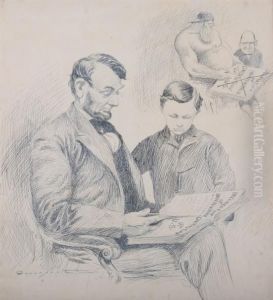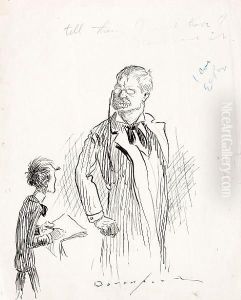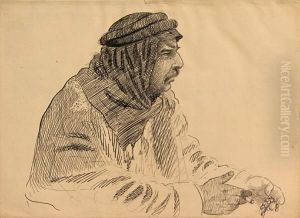Homer Calvin Davenport Paintings
Homer Calvin Davenport was an influential American cartoonist and political satirist, recognized for his sharp and distinctive commentary on American politics and society at the turn of the 20th century. Born on March 8, 1867, in Silverton, Oregon, Davenport grew up in a politically aware environment, which ignited his early interest in political satire. His father was a strong supporter of William Jennings Bryan, a fact that would later influence Davenport's political leanings and the subjects of his cartoons. Despite a lack of formal training in art, Davenport displayed a natural talent for drawing, which he honed through persistent practice and self-education.
Davenport's career as a cartoonist took off when he joined the San Francisco Examiner in the early 1890s, where his work caught the eye of newspaper magnate William Randolph Hearst. Impressed by Davenport's talent, Hearst brought him to the New York Journal, providing him with a national platform. It was here that Davenport's work gained significant attention, particularly his cartoons advocating for political reform and criticizing corruption, monopolies, and the influence of big business in government. His cartoons were bold and unapologetic, often featuring caricatures of prominent figures like Senator Mark Hanna, whom Davenport depicted as a symbol of political corruption and corporate influence.
Davenport's contributions to American political satire were profound. He was among the first to use cartoons as a means of political commentary, influencing public opinion and the course of American political dialogue. His work was characterized by a unique blend of humor, exaggeration, and poignant critique, making complex political issues accessible and engaging to the general public. Beyond his political work, Davenport was also known for his interest in Arabian horses, which led him to advocate for the preservation and promotion of Arabian horse breeding in the United States.
Homer Davenport's career was cut short when he died on May 2, 1912, in New York City, at the age of 45. Despite his relatively short life, Davenport left a lasting legacy in the world of political cartooning. His pioneering efforts helped establish the political cartoon as a crucial form of commentary in American journalism. Today, he is remembered not only for his contributions to art and politics but also for his role in shaping the early 20th-century discourse on democracy, freedom of expression, and the fight against corruption.


